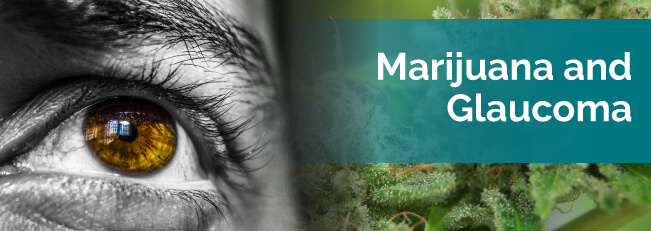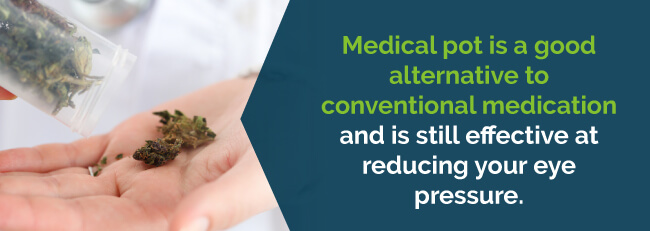
From 1970 onward, studies have been showing that medical marijuana is helping more and more patients manage the symptoms of glaucoma. Glaucoma patients can turn to medical marijuana to help manage symptoms ranging from nausea that stems from glaucoma to the intraocular pressure that can do permanent damage to the eyes. Learn what glaucoma is, how the symptoms affect the lives of patients and how glaucoma patients can start using medical marijuana to keep their symptoms under control.
Though research findings on the effectiveness of marijuana for glaucoma have been mixed, medical cannabis — often referred to as medical weed or medical pot — may help alleviate intraocular pressure (IOP) and in turn, lessen effects of the disease. Studies supported by the National Eye Institute in the 1970s showed that medical marijuana or its components, when taken orally or via inhalation, can lower intraocular pressure. And in 2003, the American Academy of Ophthalmology released a position statement which said, “Some derivatives of marijuana did result in lowering of IOP when administered orally, intravenously or by smoking, but not when topically applied to the eye.”
Because the possibility exists that marijuana may be useful in treating glaucoma, the American Academy of Ophthalmology Committee on Drugs maintains a long-term clinical study is needed to test safety and effectiveness of marijuana. However, countless patients have found relief from glaucoma symptoms with cannabis, and many marijuana states have approved marijuana use for the treatment of glaucoma.
Pot’s ability to improve glaucoma symptoms has been demonstrated in various studies, as well. Cannabis can:
Find A Doctor Find A Dispensary
Cannabis can control IOP and is neuroprotective. It also has painkilling and anti-inflammatory properties that can go a long way toward relieving your symptoms. Some strains of medical pot also work against nausea and vomiting associated with a glaucoma attack.
Medical pot is a good alternative if you’ve tried conventional glaucoma treatments and feel you need something gentler, yet still effective at reducing your eye pressure. You’re more likely to find relief from your everyday symptoms without provoking any unwanted effects in the process, too.

Your ability to access medical marijuana for glaucoma will vary considerably based on where you live. Not every U.S. state has an approved medical marijuana program and those that do have varying eligible conditions. Be sure to check with your state’s medical marijuana laws before pursuing a cannabis treatment plan for your glaucoma.
If medical marijuana is permitted for glaucoma patients in your region, you need to consult with a state-certified doctor who will determine your eligibility. They will provide you with a diagnosis and authorize your use. Once you enroll as a medical cannabis patient with the state, you will likely need to wait for your medical I.D. card in the mail. In many states, a medical I.D. card serves as verification of your authorization to purchase and use medicinal marijuana.
For more information regarding medical marijuana treatment and your ability to access this substance, contact your doctor or a marijuana-savvy physician in your city who can help you get started on the patient enrollment process.
Marijuana is quickly growing as a top medicinal choice for patients for a variety of reasons — its diversity being one of them. As a patient, not only do you have the freedom to select from dozens of different strains, but you also have the ability to choose the intake method that is best suited your health. You may not want to smoke pot due to its negative health effects. There are so many more alternatives, though, and you’re sure to find the best method for you.
How do patients with glaucoma typically use cannabis? Here’s a look at some of the most common intake methods:
Since every patient is different, it’s best to discuss your marijuana treatment options with a certified medical professional first.
Pot continues to be prohibited at the federal level in the United States. Nonetheless, several states have legalized its medical and recreational use. You need to have a diagnosis of a condition that’s on your own state’s list of qualifying medical marijuana conditions to be approved to use medical cannabis for glaucoma.
You also need to have a medical cannabis physician’s recommendation, which will get you a medical pot card. As soon as you have this, you can visit dispensaries to buy the medical pot for your own specific needs.
There are several useful strains of medical marijuana for glaucoma that are readily available to buy from dispensaries. Each strain has its distinct effects. You should have a conversation with an experienced budtender and/or your medical cannabis doctor to figure out what strains may be best for your specific needs. In the meantime, look at this short list of useful glaucoma strains based on what symptoms you want to relieve.
Suffering from pressure behind the eyes can lead to optic nerve damage and even blindness. Thankfully, there are various cannabis strains that may be able to help relieve this. These include:
CBD and THC in cannabis can relieve nerve pain. They reduce brain inflammation and regulate pain signals in your body. The following strains have good levels of neuroprotective terpenes and should help with your pain:
Nausea and vomiting attacks can be debilitating when you have glaucoma. The following medical pot strains can alleviate these symptoms:

Having glaucoma is stressful. Worrying about your vision problems can take over your life. Depending on the type of glaucoma you have, you may have suffered a painful attack, or you could have no symptoms at all.
Your quality of life can be dramatically diminished if you have begun to or have lost your vision. You may not respond as well as you might have hoped to treatments. All that worrying can have a negative impact on your immune system, and you feel frequently fatigued. You may even develop clinical depression. You may lose interest in activities you once enjoyed, especially ones that require good vision and concentration.
Fortunately, if you’re adversely impacted by glaucoma symptoms, you have treatment options — including prescription eye drops, surgery and medical cannabis — that can help you maintain your vision and quality of life.
Are you interested in exploring a medical marijuana plan for glaucoma? If so, it’s crucial to explore this eye condition in more detail, first. Below, we’ll outline everything you’ll want to know about glaucoma to better prepare you for your upcoming treatment.
Inside the eye are two fluid-filled chambers. The intraocular fluid, or eye fluid, is responsible for maintaining the correct amount of pressure inside the eye – which keeps the shape of the eye intact. This fluid is clear and watery in the front, or anterior chamber of the eye. The larger back chamber, or posterior chamber, is filled with a thick jelly-like fluid which is referred to as the vitreous humor. The clear and watery eye fluid in the anterior chamber is called the aqueous humor – which is continually being formed and absorbed as it flows through the eye. This fluid is formed near the lens, flows to the front chamber of the eye and then drains into the venous system through a tiny drainage duct. Glaucoma, which is a common cause of blindness, is a disease that affects the drainage of the aqueous humor causing pressure to build within the eye. There are many types and causes of glaucoma. Often, glaucoma occurs when either a sponge-like meshwork that filers eye fluid becomes compacted and prevents fluid from entering the duct or when the iris of the eye covers the canal opening. In either case, the accumulation of fluid within the eye creates pressure that pushes on the back of the eye and damages the optic nerve. This nerve is responsible for transmitting the images to the brain. Over time, the increased pressure can result in blind spots and even total blindness. Appropriate therapy can halt or slow disease progression but cannot restore lost vision. Learn more below about how medical marijuana can help treat glaucoma.
More than 3 million Americans are estimated to suffer from glaucoma, a disease of the major nerve of vision called the optic nerve. Without diagnosis and treatment, glaucoma can progress to loss of central vision and blindness. Worldwide, glaucoma is the leading cause of irreversible blindness.

For good vision, you need a healthy optic nerve. The nerve itself consists of over a million nerve fibers. It connects your retina — the light-sensitive tissue at the back of your eye — to your brain. With glaucoma, fluid usually builds up in the front part of your eye, putting extra pressure within your eye and damaging the optic nerve.
There are two main types of glaucoma — primary open-angle glaucoma and angle-closure glaucoma, also known as narrow-angle or closed-angle glaucoma.
Primary open-angle glaucoma is the most common type. The condition comes on gradually. Your eye won’t drain fluid as well as it should. Eye pressure then builds and begins to damage your optic nerve. You won’t feel any pain or notice any vision changes in the early stages.
Some people have optic nerves that are more sensitive to pressure, which heightens your risk of developing glaucoma. Regular eye exams are essential so your doctor can identify and treat your condition early.
Angle-closure glaucoma develops when the drainage angle in your eye is particularly close to your iris. It is so close, in fact, that your iris can block the drainage angle, resulting in a rapid rise in eye pressure. When this happens, it’s known as an acute attack, and it is an emergency situation. You could go blind if you don’t contact an ophthalmologist immediately.
Some, but not all, people with this type of glaucoma develop the condition very slowly. There will be no damage at all in the beginning. You won’t know you have the condition until you have an attack or your damage becomes severe. You can go blind if you don’t get treatment immediately for acute attacks that elevate your eye pressure levels dangerously.
The majority of other types of glaucoma are variations of the above types. Any of these conditions can affect one or both your eyes. These include:
There are certain factors that make it more likely for you to develop glaucoma. These include:
As one of the leading causes of eye complications, it’s vital to explore the primary causes and risk factors associated with cannabis. Medically, glaucoma is defined by a deterioration in vision and increased pressure in the eye.
Although doctors can’t pinpoint an exact reason for this issue, it’s likely that genetics play a role in the formation of glaucoma for certain patients. Other causes of glaucoma include previous eye infections, injury, optic nerve damage and poor blood flow.
Glaucoma was first diagnosed in ancient times. Hippocrates described a blindness condition, named glaykoseis, that occurred in the elderly. The English ophthalmologist Richard Banister was the first to make the connection between glaucoma and heightened eyeball tension.
Then, in 1850, Hermann von Helmholtz invented the ophthalmoscope. Glaucoma was then easier to detect in patients. In 1856, Albrecht von Graefe carried out an iridectomy that turned out to be the first effective surgery for the condition. Drug treatment with pilocarpine began in 1875.
Fortunately, the medical community’s extensive research on glaucoma and its impact on patients throughout history has had a positive impact on the formation of the current treatment plans that individuals enjoy today.
If you’re dealing with the symptoms of glaucoma, you’re not alone. Take a look at these statistics collated by the Glaucoma Research Foundation regarding the prevalence of the condition and who is affected:

Symptoms of angle-closure glaucoma include:
These symptoms are very pronounced, and eye damage happens rapidly. Make an appointment with an ophthalmologist without delay if you experience any of the above.
Symptoms of open-angle glaucoma are less obvious than that of acute angle-closure glaucoma. There are typically no painful symptoms or early warning signs of open-angle glaucoma. The disease develops slowly, and you might not detect any sight loss for several years, especially if you don’t see your eye care practitioner regularly. Your vision may remain sharp until you’re in the later stages of the disease. You perhaps won’t notice your peripheral vision is deteriorating.
Unfortunately, the disease can be rather advanced by the time you’re usually aware of any vision loss. Glaucoma can lead to blindness if not treated. Regular eye examinations are crucial for this reason.
Rapid treatment for some types of glaucoma can delay its progression. Effective treatment for glaucoma involves the use of drugs or surgical procedures that prevent progressive optic nerve damage. The only method of accomplishing this is by lowering intraocular pressure. There are various conventional ways to treat the disease, including:
You may be prescribed oral medications or eye drops in the early stages of the disease. Prescription eye drops decrease the amount of fluid your eye produces and/or improve the way fluid drains from your eyes.
Prescription eye drop medications include:
Oral medications or prescription eye drops can lower eye pressure, but can sometimes cause varying side effects, including headaches, slowed breathing, eye stinging, metallic taste, tingling in the toes and fingers, nearsightedness, dim vision, blurry vision, changes in the pigment of the eyelids or eyelashes, impotence, fatigues, dry mouth or high or low blood pressure.
Laser trabeculoplasty is a procedure performed at an eye clinic or in your doctor’s office. Numbing drops and a laser are applied to your eye. The laser works to enable the fluid to drain better. Side effects of the treatment include inflammation.
Conventional surgery is usually carried out when laser surgery and medications have been unable to control eye pressure. It involves making a new opening for fluid to leave your eye. The surgery, known as trabeculectomy, consists of a small piece of tissue being removed, creating a new channel for fluid drainage.
You need to use special eye drops to combat inflammation and infection for several weeks after the surgery. If both your eyes are affected, your doctor will do one surgery per eye, approximately four to six weeks apart.
Conventional surgery offers a 60 to 80 percent success rate, though your vision may never be as good as it was before your surgery. Potential complications include:
The below habits and home remedy tips may help you manage your eye pressure.
Research is ongoing in the treatment of glaucoma. New medications, surgical procedures, medication delivery methods and devices, such as the iStent and others, are being evaluated for their effectiveness.
Medical marijuana is a real alternative if you’re having difficulty with conventional glaucoma treatments and don’t like their side effects.
Choosing the right medical pot strain can be a case of trial and error. Everyone’s experience will be slightly different. Medical marijuana could be for you if you’re searching for a means to gently and naturally alleviate your glaucoma symptoms. Search for a medical marijuana doctor or dispensary today to learn even more about cannabis and glaucoma.
Find A Doctor Find A Dispensary